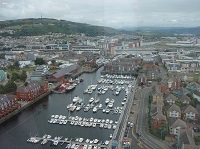The Government’s Hendry report issued today has given a cautious backing for the financial case for tidal lagoons but it failed to examine the environmental impact of these colossal developments or to consider alternative technologies to generate tidal power which are currently being developed.
The report also bases its assessment of the economics on a 120 year lifetime – double the 60 years initially suggested by the developers – which is unrealistic due to the high risk of the lagoons filling with sediment well before the year 2140, by which time there will inevitably have been technological developments for renewable power generation which will make lagoon technology seem like ancient history.
 Natural Resources Wales has already concluded [note 1] that there could be a major adverse impact on fish populations, such as fragile salmon and sea trout stocks, from the currently-proposed Swansea Bay lagoon design. The regulator has indicated that it would not be able to grant the project the Marine Licence it needs to go ahead based on the evidence supplied to date by developers Tidal Lagoon Power.
Natural Resources Wales has already concluded [note 1] that there could be a major adverse impact on fish populations, such as fragile salmon and sea trout stocks, from the currently-proposed Swansea Bay lagoon design. The regulator has indicated that it would not be able to grant the project the Marine Licence it needs to go ahead based on the evidence supplied to date by developers Tidal Lagoon Power.
The Swansea scheme only begins to make any economic sense at all if the much larger lagoon near Cardiff were also to be constructed, but this is sited in an even more sensitive environmental area than Swansea Bay, with several international conservation designations related to salmon, shad, eels and lamprey, as well as rare marine habitats which could be destroyed.
In 2010, a report to the then Department of Energy and Climate Change [note 2] concluded that tidal lagoons in the Severn Estuary could cause the extinction of some of these fish populations. In 2015, Natural Resources Wales indicated that these conclusions were still valid.
Major concerns have also been raised by expert tidal geomorphologists about the effect of the lagoons on sediment deposition in the silt-laden waters of the Severn estuary, with some suggesting that the lifespan of the lagoons should be shortened to one or two decades rather than the 95 years on which the Hendry report bases its calculations of value for money, which would blow the economic case for public support out of the water.
Large amounts of energy would be expended mining and transporting vast quantities of rock from the proposed quarry site in Cornwall – the use of which has also been successfully challenged in the courts by local community and environmental groups in the area – before any energy is generated from the tides.
Building such huge developments in the Severn Estuary could prevent the exploitation of tidal energy by alternative, more benign technologies which are currently in development and others which have not yet been developed. There is undoubtedly great potential for renewable energy generation around the UK coastline, but this should only be permitted if it can be proven not to cause unacceptable damage to the environment.
Mark Lloyd, Chief Executive of the Angling Trust & Fish Legal, said: “Tidal Lagoon Power has done a first rate job at spinning this project politically, but the company has failed spectacularly to quantify convincingly the impacts on sediment deposition, local communities, wildlife and fisheries, which are of particular interest to our members. The Government should avoid giving its backing to what could be a colossal series of white elephants before carrying out a more strategic assessment of the sustainable management of the Severn Estuary and other areas with large tidal ranges around the UK. It is impossible to see how lagoons could be built while meeting the government’s headline commitment to leave the environment in a better state for the next generation.”







